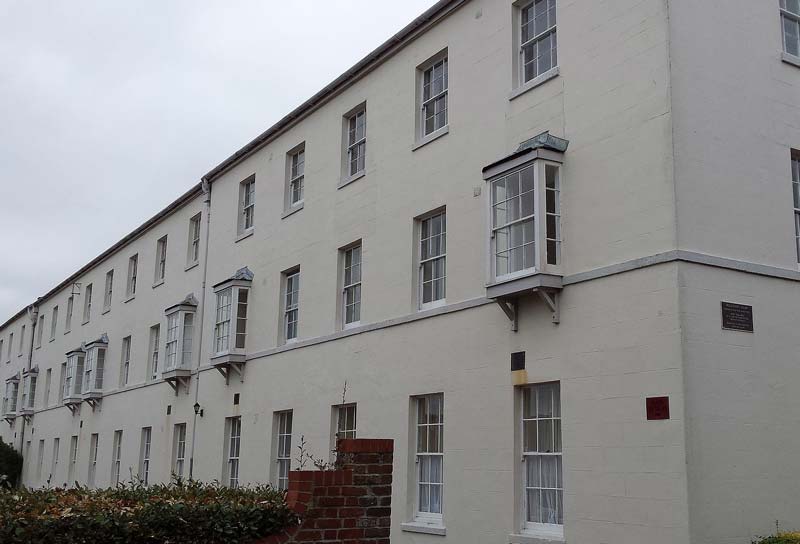Start: Holy Trinity Church, there Trinity Road
Finish: Cove Row
Distance: 2.3km
Terrain: Mainly easy but there are very steep steps leading to Nothe Gardens – wheelchair users will need to use alternative route of Barrack Road
This walk continues from Part One. If you have not walked Part One but would like more information about Georgian Weymouth please take a moment to read the introduction in that section.
Starting at Holy Trinity Church, which just scrapes into the Georgian era by a year as opened in 1836, a year before Queen Victoria took the Crown. Proceed right along Trinity Road. If you’re feeling brave take the dark alleyway by the right of the church that takes you past the catacombs and gloomy doorways. Look out for the spiders!
To your left is the Kings Arms Inn originally built in the 16th century but remodelled with a Georgian frontage in the 18th century.
Walk towards No 2 Trinity Road which is the former residence of Ralph Allen who is often credited as the originator of visiting wealthy Georgians to this seaside town. He was a wealthy big shot of the day that was advised by his doctor to bring his ill wife to Weymouth to take the saltwater cure. He then invited the Duke of Gloucester who in turn invited his brother King George, and the rest is history.
Turn into Trinity Street. The first building on the left is Trinity House which was built in Georgian times. Immediately next door is the Old Rooms which are of Elizabethan origins (opposite Hope Chapel). It once backed onto the harbour. During the 18th century the building became the Delamotte’s Assembly Rooms and it was here the Duke of Gloucester, prior to the building of Gloucester Lodge, took tea on a visit to the town in 1771. During the Napoleonic War it became an inn with dubious dealings such as smuggling and press gangs.
During the Napoleonic Wars Weymouth became a hunting ground for press gangs. These gangs were looking for men to “volunteer” for the navy – a dangerous career back then. These volunteers were often knocked unconscious or threatened. When the press gang had seized a man he was offered the Kings Shilling as payment. The coin was often issued in devious and underhand away such as slipping in a pocket or drink. This is why tankards had glass bottoms so men could see what they were drinking.
Walk past the Tudor House onto Hope Square and then cut across the square onto Cove Street making your way back to the harbour.
To your left is the old town pump outside the Old Rooms Inn. It was originally erected in 1775 at North Quay where the beginning of the Old High Street for families to collect water but was moved here in 1990.
From the town pump continue along the terrace cottages of Cove Row and wander along Hope Street. At No 22 look up and you will see a bracket for holding the sign for the Hope Tavern that was formerly here.
In Georgian times there were a row of houses opposite this tavern which backed straight on to the Harbour which was convenient for the smugglers.
At No 23 you will see that one of the windows has been blocked up in to avoid Window Tax. William Pitt (the Younger) led Georgian Britain through many wars with France which became expensive so he needed to squeeze more cash out of the public. One way was to put up taxes including the highly unpopular Window Tax for houses with more than seven windows. This is where the phrase daylight robbery comes from.
Walk along Nothe Parade.
Where the bridge crosses the slipway there is an old established shipyard. Alongside the shipyard is No 10a which was the Slip masters House dating from about 1780. In Georgian times there were many wharfs alongside this side of the harbour. In 1794 the packet steamer service (postal service) was launched to operate between the Channel Islands and Weymouth. There were originally two eighty ton clippers called Chesterfield and Rover. There were fears of attack by French privateers and the Admirality had been asked to protect the sailings. All went well until the 29th October 1811. The privateer ship L’epervier carrying 14 guns and a crew of 50 captured the Chesterfield. A fight ensued and Chesterfield’s Captain and two other men were killed and several wounded.
Follow the path that takes you past the Sailing and Rowing Clubs. Walk past Stone Pier Cafe towards the pier and continue till you find the plaque telling the story of the ship wreck – The Earl of Abergavenny where 263 drowned. The story caught the public’s imagination and the wreck became a top tourist attraction that even King George visited with his family. Wood from the wreckage was made into artefacts to sell to tourists and even used in a local cottage beam.
Retrace your steps back past the cafe and take the immediate first path and steps to the Nothe Gardens and the Fort. Be careful as the path is fairly steep and could be slippery in the wet.
There has been a fort here since Henry VIII time but the present structure was built around 1870, thus a Victorian structure.
Wander along the top path, known as Elizabethan Walk, towards Barrack Road – which is situated by the cafe at the main entrance to the gardens.
Walk down Barrack Street past the Coastguard Cottages and Nothe Tavern till you reach the Quakers Friends Burial Ground. This was established in 1713 and used till 1834. Most of the gravestones have now gone including one for a little girl who drowned after the sinking of the Earl of Abergavenny. This burial ground has recently been transformed into a multi faith community garden and is a lovely place to relax for a few minutes.
Next to the garden is Wellington Court, formerly the Red Barracks. King George III recognised the need to increase Britain’s defences against possible invasion from Napoleon’s French troops and these barracks were one of three in Weymouth. They were built in 1796 but burnt down in 1798 and rebuilt in 1801 around a parade area. It had accommodation for 17 officers and 270 men and housed a 30 bed hospital. During the Napolenic War it stationed troops from Hanover. Two soldiers became homesick and when they saw a mysterious blue light glowing from the Quakers Burial Ground they took it as a sign that they should go home to Hanover. They stole a small boat from the harbour, but soon run into trouble and were picked up by an English Cutter. They were court martialed and found guilty of treason. They were shot one early morning. Their graves lay unmarked in Bincombe graveyard – many miles from their homes.
The barracks were used by the armed forces for 150 years. They have since been converted to housing.
Carry on down Barrack Street passing the former Military Arms Inn which would of been a popular drinking hole with the troops..
Carry on down Hill Lane into Horsford Street with its pretty houses. Take a peek at the Look Out on the left hand side for some great views.
At the bottom of the street turn right into Spring Road which leads back into Hope Square. Cross the square in front of Brewers Quay and walk down Hope Street.
Pilgrim House was formerly known as the White House and was the home of a successful merchant.
No 6 is a great example of 18th century building with Portland stone. Hope Street was once on the water’s edge which ran back as far as what is now Hope Square and had houses on both sides, some right by the water. The ope was filled in 1782 across the mouth of the inlet.
At the end of Hope Street is Cove Row and that is the end of the walk.
Sources
The Buildings of Old Weymouth – Eric Ricketts
Maureen Attwool & Jack West – Weymouth An Illustrated History
By Fiona for weymouthwalks.co.uk
Image by Richard Symonds – Own work, CC BY-SA 4.0, https://commons.wikimedia.org/w/index.php?curid=51132357

